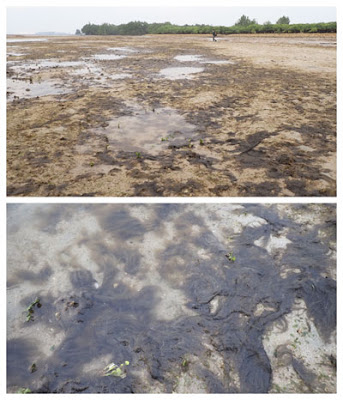Here, there are corals, seagrasses and mangroves which seem to be hanging on. We narrowly escaped a lightning storm at the end of our survey and got back on the boat just in time.
There has never been a lot of hard corals on this shore. I saw Cauliflower corals, Anemone corals and the usual common boulder shaped corals. Although some were pale, most seemed alright. I didn't see any mass coral bleaching.
As on our last survey in May 2023, I saw some small clumps of Branching montipora coral - hopefully they will form a 'field' like they do on some of our other nearby shores.
I saw a few medium sized Leathery soft corals of various kinds. They all seemed alright.
I saw Noble volutes and the common sea anemones that are usually abundant here: Giant carpet anemones, Fire anemones. There were also the usual colourful sponges seen on reefs.
On the sand bar near the mouth of the stream, there were signs of the usual sand dwellers - Olive snails, Sand bubbler crabs. There were also many Common sea stars in the area. I am very relieved we didn't see any nets on the shore today.
The rest of the team saw many small Upsidedown jellyfish, small cuttlefishes and small octopuses. Also, a bright blue carpet anemone. Links to their albums at the end of the post.
 |
| Montage of photos by others on the survey. |
At the mouth of the stream running out of the mangroves, there were patches of Spoon seagrasses, with sprinkles of other seagrass species. This is similar to what we saw in Jan 2022 and Dec 2022 and May 2023.
I went a short way northward and the shores were bare of seagrasses. Most of the Tape seagrass I saw remain cropped, some very short.
There has been a large expansion of the area covered by Horse mussel clams from the landfill seawall to the stream opening between the old mangrove and replanted mangroves. This suggests some sort of imbalance in the ecosystem. I already noticed during our last survey in Dec 2022 that they seem to be spreading out. In Jan 2020 and Mar 2019, I saw them in small groups of less than 10, spread apart. In Oct 2020, there were a lot more and closer together. Covering an area of about 20m2. The situation was similar in Jan 2022, and during our survey in May 2023. The area is opposite Barramundi Asia fish farm and most of the mussels were very much alive.
There seems to be a bloom of cyanobacteria - clumps of fine black hairy organisms, covering a large area near the mouth of the stream.
Every time we survey this shore, we check out the Barramundi Group's fish farm that is located very close to natural mangroves, reefs and seagrass meadows there.
It seems quiet on the farm today. In Jul 2023, it was reported that Barramundi Group will stop stocking its sites off Pulau Semakau, Pulau Senang and St John’s Island until “an efficacious vaccine is available” against the scale drop disease virus (SDDV). SDDV was first formally described in Singapore farmed fish in 2011 and can kill more than half of the barramundi raised in a cage. The virus has caused “significant mortalities and financial losses” for Barramundi Group's Singapore operations, which recorded a loss of $31.9 million for FY2022.More about Pulau Semakau
It is NOT true that the construction of the Landfill created the marine life found on Pulau Semakau. The marine life was there long before the Landfill was built.
Just as Changi Airport and Changi Beach are not the same even though they are near one another and share a name, Pulau Semakau is NOT the same as the Semakau Landfill. The Landfill was created by destroying all of Pulau Saking, and about half of the original Pulau Semakau by building a very long seawall. Fortunately, the landfill was constructed and is managed in such a way that the original mangroves, seagrass meadows and reefs on Pulau Semakau were allowed to remain.
What is the fate of Pulau Semakau South?
These shores slated for massive reclamation outlined recently in the Long-Term Plan Review.
The Singapore Blue Plan 2018
Pulau Semakau and nearby islands and submerged reefs have been recommended by the Singapore Blue Plan 2018 for Immediate Conservation Priority. The Blue Plan recommends the intertidal and subtidal marine areas of Pulau Semakau and adjacent Pulau Hantu, and Pulau Jong to be designated Marine Reserve.
The Blue Plan highlights that Pulau Semakau and its associated patch reefs comprise many ecosystems: coral reefs, mangrove areas, intertidal sandflats, seagrass meadows, and coral reefs. The subtidal area of Pulau Jong is larger than the terrestrial area. Pulau Hantu is a popular dive site has seen increasing interest in the past decade due to biodiversity awareness. If protection is accorded to these three islands, zonation plans for use can be implemented to manage tourism and human impacts.
DOWNLOAD the Plan, SUPPORT the Plan! More on the Singapore Blue Plan 2018 site.
Photos by others on this survey
James Koh
Richard Kuah
Kelvin Yong
Loh Kok Sheng
Tammy Lim
Others on this survey: Tommy Arden.
















